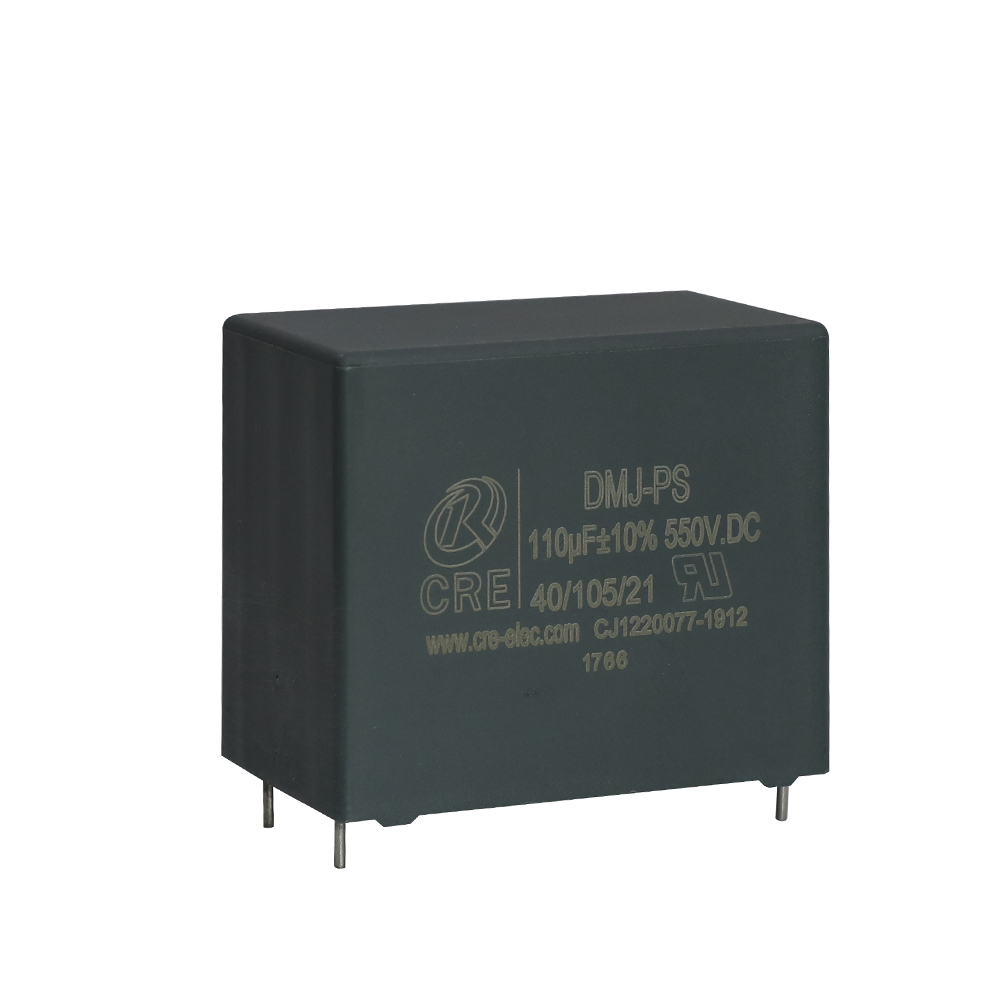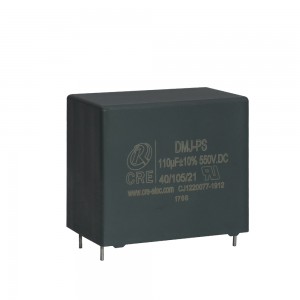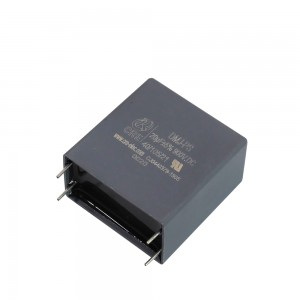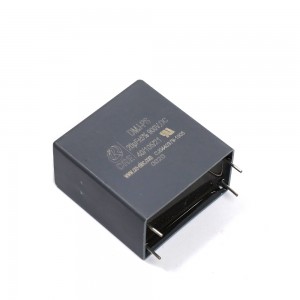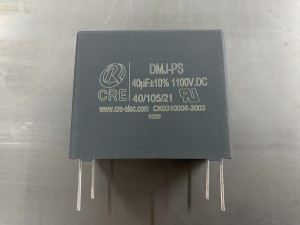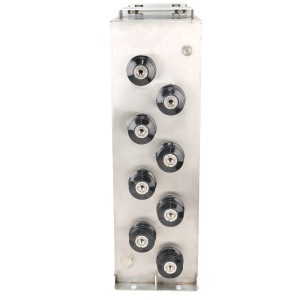Condensatore a film del collegamento CC montato su PCB progettato per inverter fotovoltaico
Serie DMJ-PS
Condensatori di filtraggio del collegamento CC utilizzati per convertitori e inverter di potenza CA/CC.
Gli elementi condensatori autoriparanti di tipo secco sono prodotti utilizzando una pellicola in PP metallizzata con profilo speciale che garantisce bassa autoinduttanza, elevata resistenza alla rottura ed elevata affidabilità.La disconnessione per sovrapressione non è considerata necessaria.La parte superiore del condensatore è sigillata con resina epossidica ecologica autoestinguente.Lo speciale design garantisce un'autoinduttanza molto bassa.
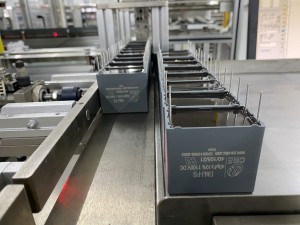
Tabella delle specifiche
| Voltaggio | 550 V.CC (85 ℃) 600 V (70 ℃) | |||||||||||
| Cn (uF) | numero di fili | φD (mm) | L(mm)±1 | T(mm)±1 | H(mm)±1 | Passo (mm) | VES (mΩ) | ESL (nH) | dv/dt (V/μS) | IPK (A) | Irm (A) (@10KHz 85℃) | |
| P1 | P2 | |||||||||||
| 4 | 2 | 0,8 | 32 | 11 | 21 | 27.5 | 20.5 | 10 | 75 | 300 | 4 | |
| 7 | 2 | 0,8 | 32 | 15 | 25 | 27.5 | 11.5 | 10 | 75 | 525 | 6.5 | |
| 10 | 2 | 1 | 32 | 18 | 28 | 27.5 | 8 | 10 | 75 | 750 | 9 | |
| 12 | 2 | 1 | 32 | 21 | 31 | 27.5 | 7 | 10 | 75 | 900 | 10 | |
| 20 | 2 | 1.2 | 42,5 | 24.5 | 27.5 | 37,5 | 7 | 10 | 40 | 800 | 11 | |
| 30 | 4 | 1.2 | 42,5 | 24 | 44 | 37,5 | 20.3 | 6.5 | 10 | 40 | 1200 | 15 |
| 45 | 4 | 1.2 | 42,5 | 29 | 37 | 37,5 | 20.3 | 6 | 10 | 40 | 1800 | 17 |
| 60 | 4 | 1.2 | 42,5 | 30 | 45 | 37,5 | 20.3 | 4.5 | 15 | 40 | 2400 | 18.5 |
| 60 | 4 | 1.2 | 42,5 | 33 | 45 | 37,5 | 20.3 | 4.5 | 15 | 40 | 2400 | 18.5 |
| 75 | 4 | 1.2 | 42,5 | 35 | 50 | 37,5 | 20.3 | 3 | 15 | 20 | 1500 | 19 |
| 75 | 4 | 1.2 | 57,5 | 30 | 45 | 52,5 | 20.3 | 3.2 | 15 | 20 | 1500 | 18 |
| 100 | 4 | 1.2 | 42,5 | 40 | 55 | 37,5 | 20.3 | 2.8 | 15 | 20 | 2000 | 20 |
| 100 | 4 | 1.2 | 57,5 | 35 | 50 | 52,5 | 20.3 | 3 | 15 | 20 | 2000 | 22 |
| 110 | 4 | 1.2 | 57,5 | 35 | 50 | 52,5 | 20.3 | 3 | 15 | 20 | 2200 | 23 |
| 120 | 4 | 1.2 | 57,5 | 38 | 54 | 52,5 | 20.3 | 2.8 | 15 | 20 | 2400 | 25 |
| 150 | 4 | 1.2 | 57,5 | 42,5 | 56 | 52,5 | 20.3 | 2.5 | 15 | 20 | 3000 | 28 |
| 150 | 4 | 1.2 | 57,5 | 45 | 55 | 52,5 | 20.3 | 2.5 | 15 | 20 | 3000 | 28 |
| 200 | 4 | 1.2 | 57,5 | 45 | 65 | 52,5 | 20.3 | 2.3 | 15 | 20 | 4000 | 28 |
| Voltaggio | 700 V.CC(85 ℃)800 V(70 ℃) | |||||||||||
| Cn (uF) | numero di fili | φD (mm) | L(mm)±1 | T(mm)±1 | H(mm)±1 | Passo (mm) | VES (mΩ) | ESL (nH) | dv/dt (V/μS) | IPK (A) | Irm (A) (@10KHz 85℃) | |
| P1 | P2 | |||||||||||
| 3 | 2 | 0,8 | 32 | 11 | 21 | 27.5 | 23 | 10 | 75 | 225 | 4 | |
| 5 | 2 | 0,8 | 32 | 15 | 25 | 27.5 | 14 | 10 | 75 | 375 | 6 | |
| 8 | 2 | 1 | 32 | 18 | 28 | 27.5 | 8.5 | 10 | 75 | 600 | 8.5 | |
| 10 | 2 | 1 | 32 | 21 | 31 | 27.5 | 7 | 10 | 75 | 750 | 10 | |
| 10 | 2 | 1.2 | 42,5 | 24.5 | 27.5 | 37,5 | 10 | 10 | 40 | 400 | 10 | |
| 20 | 4 | 1.2 | 42,5 | 24 | 44 | 37,5 | 20.3 | 7.5 | 10 | 40 | 800 | 12 |
| 25 | 4 | 1.2 | 42,5 | 29 | 37 | 37,5 | 20.3 | 6 | 10 | 40 | 1000 | 12 |
| 40 | 4 | 1.2 | 42,5 | 33 | 45 | 37,5 | 20.3 | 5.5 | 10 | 40 | 1600 | 13 |
| 40 | 4 | 1.2 | 57,5 | 30 | 45 | 52,5 | 20.3 | 6 | 15 | 20 | 800 | 15 |
| 45 | 4 | 1.2 | 42,5 | 35 | 50 | 37,5 | 20.3 | 5 | 10 | 40 | 1800 | 15 |
| 50 | 4 | 1.2 | 57,5 | 30 | 45 | 52,5 | 20.3 | 5.5 | 15 | 20 | 1000 | 18 |
| 55 | 4 | 1.2 | 42,5 | 40 | 55 | 37,5 | 20.3 | 4.5 | 10 | 40 | 2200 | 18 |
| 60 | 4 | 1.2 | 57,5 | 35 | 50 | 52,5 | 20.3 | 5 | 15 | 20 | 1200 | 20 |
| 75 | 4 | 1.2 | 57,5 | 35 | 50 | 52,5 | 20.3 | 4.5 | 15 | 20 | 1500 | 22 |
| 80 | 4 | 1.2 | 57,5 | 38 | 54 | 52,5 | 20.3 | 4 | 15 | 20 | 1600 | 22 |
| 90 | 4 | 1.2 | 57,5 | 42,5 | 56 | 52,5 | 20.3 | 3.5 | 15 | 20 | 1800 | 25 |
| 100 | 4 | 1.2 | 57,5 | 42,5 | 56 | 52,5 | 20.3 | 3.2 | 15 | 20 | 2000 | 27.5 |
| 100 | 4 | 1.2 | 57,5 | 45 | 55 | 52,5 | 20.3 | 3.2 | 15 | 20 | 2000 | 27.5 |
| 110 | 4 | 1.2 | 57,5 | 45 | 65 | 52,5 | 20.3 | 3 | 15 | 20 | 2200 | 28 |
| Voltaggio | 800 V.CC(85℃)900 V(70℃) | |||||||||||
| Cn (uF) | numero di fili | φD (mm) | L(mm)±1 | T(mm)±1 | H(mm)±1 | Passo (mm) | VES (mΩ) | ESL (nH) | dv/dt (V/μS) | IPK (A) | Irm (A) (@10KHz 85℃) | |
| P1 | P2 | |||||||||||
| 2 | 2 | 0,8 | 32 | 11 | 21 | 27.5 | 31 | 10 | 75 | 150 | 3.5 | |
| 4 | 2 | 0,8 | 32 | 15 | 25 | 27.5 | 15.5 | 10 | 75 | 300 | 5.5 | |
| 6 | 2 | 1 | 32 | 18 | 28 | 27.5 | 10.5 | 10 | 75 | 450 | 7.5 | |
| 8 | 2 | 1 | 32 | 21 | 31 | 27.5 | 8 | 10 | 75 | 600 | 9.5 | |
| 15 | 2 | 1.2 | 42,5 | 24 | 44 | 37,5 | 10 | 10 | 40 | 600 | 10 | |
| 20 | 4 | 1.2 | 42,5 | 29 | 37 | 37,5 | 20.3 | 7.5 | 10 | 40 | 800 | 12 |
| 30 | 4 | 1.2 | 42,5 | 33 | 45 | 37,5 | 20.3 | 4.5 | 10 | 40 | 1200 | 16 |
| 35 | 4 | 1.2 | 57,5 | 30 | 45 | 52,5 | 20.3 | 5.5 | 15 | 20 | 700 | 14 |
| 45 | 4 | 1.2 | 42,5 | 35 | 50 | 37,5 | 20.3 | 4.2 | 10 | 40 | 1800 | 17 |
| 50 | 4 | 1.2 | 57,5 | 35 | 50 | 52,5 | 20.3 | 4.5 | 15 | 20 | 1000 | 18 |
| 55 | 4 | 1.2 | 42,5 | 40 | 55 | 37,5 | 20.3 | 4 | 10 | 40 | 2200 | 18 |
| 60 | 4 | 1.2 | 57,5 | 38 | 54 | 52,5 | 20.3 | 4.5 | 15 | 20 | 1200 | 20 |
| 70 | 4 | 1.2 | 57,5 | 42,5 | 56 | 52,5 | 20.3 | 3.5 | 15 | 20 | 1400 | 22 |
| 75 | 4 | 1.2 | 57,5 | 45 | 55 | 52,5 | 20.3 | 3.2 | 15 | 20 | 1500 | 24 |
| 85 | 4 | 1.2 | 57,5 | 45 | 65 | 52,5 | 20.3 | 3 | 15 | 20 | 1700 | 26 |
| Voltaggio | 1100 V CC (85 ℃) 1200 V (70 ℃) | |||||||||||
| Cn (uF) | numero di fili | φD (mm) | L(mm)±1 | T(mm)±1 | H(mm)±1 | Passo (mm) | VES (mΩ) | ESL (nH) | dv/dt (V/μS) | IPK (A) | Irm (A) (@10KHz 85℃) | |
| P1 | P2 | |||||||||||
| 1 | 2 | 0,8 | 32 | 11 | 21 | 27.5 | 45,5 | 10 | 95 | 95 | 3 | |
| 2 | 2 | 0,8 | 32 | 15 | 25 | 27.5 | 23 | 10 | 95 | 190 | 4.5 | |
| 3 | 2 | 1 | 32 | 18 | 28 | 27.5 | 15.5 | 10 | 95 | 285 | 6 | |
| 4 | 2 | 1 | 32 | 21 | 31 | 27.5 | 11.5 | 10 | 95 | 380 | 8 | |
| 10 | 2 | 1.2 | 42,5 | 24 | 44 | 37,5 | 11 | 10 | 40 | 429 | 11 | |
| 15 | 4 | 1.2 | 42,5 | 29 | 37 | 37,5 | 20.3 | 8 | 10 | 40 | 600 | 15 |
| 20 | 4 | 1.2 | 42,5 | 30 | 45 | 37,5 | 20.3 | 5 | 10 | 40 | 800 | 18 |
| 20 | 4 | 1.2 | 42,5 | 33 | 45 | 37,5 | 20.3 | 5 | 10 | 40 | 800 | 18 |
| 20 | 4 | 1.2 | 57,5 | 30 | 45 | 52,5 | 20.3 | 7 | 15 | 25 | 500 | 15 |
| 25 | 4 | 1.2 | 57,5 | 35 | 50 | 52,5 | 20.3 | 6 | 15 | 25 | 625 | 17 |
| 30 | 4 | 1.2 | 57,5 | 35 | 50 | 52,5 | 20.3 | 5 | 15 | 25 | 750 | 18 |
| 35 | 4 | 1.2 | 42,5 | 35 | 50 | 37,5 | 20.3 | 4.5 | 10 | 40 | 1400 | 19 |
| 40 | 4 | 1.2 | 57,5 | 35 | 50 | 52,5 | 20.3 | 5 | 15 | 25 | 1000 | 18 |
| 45 | 4 | 1.2 | 57,5 | 38 | 54 | 52,5 | 20.3 | 4.5 | 15 | 25 | 1125 | 18.5 |
| 50 | 4 | 1.2 | 57,5 | 42,5 | 56 | 52,5 | 20.3 | 3.5 | 15 | 25 | 1250 | 20 |
| 55 | 4 | 1.2 | 57,5 | 42,5 | 56 | 52,5 | 20.3 | 3.5 | 15 | 25 | 1375 | 21 |
| 60 | 4 | 1.2 | 57,5 | 45 | 55 | 52,5 | 20.3 | 3.2 | 15 | 25 | 1500 | 22 |
| 70 | 4 | 1.2 | 57,5 | 45 | 65 | 52,5 | 20.3 | 3 | 15 | 25 | 1750 | 24 |
| Voltaggio | 1200 V CC (85 ℃) 1500 V (70 ℃) | |||||||||||
| Cn (uF) | numero di fili | φD (mm) | L(mm)±1 | T(mm)±1 | H(mm)±1 | Passo (mm) | VES (mΩ) | ESL (nH) | dv/dt (V/μS) | IPK (A) | Irm (A) (@10KHz 85℃) | |
| P1 | P2 | |||||||||||
| 1 | 2 | 0,8 | 32 | 11 | 21 | 27.5 | 43 | 10 | 100 | 100 | 3 | |
| 2 | 2 | 0,8 | 32 | 15 | 25 | 27.5 | 21.5 | 10 | 100 | 200 | 5 | |
| 3 | 2 | 1 | 32 | 18 | 28 | 27.5 | 14.5 | 10 | 100 | 300 | 6.5 | |
| 4 | 2 | 1 | 32 | 21 | 31 | 27.5 | 11 | 10 | 100 | 400 | 8 | |
| 12 | 4 | 1.2 | 42,5 | 30 | 45 | 37,5 | 20.3 | 5 | 10 | 50 | 600 | 15 |
| 12 | 4 | 1.2 | 57,5 | 30 | 45 | 52,5 | 20.3 | 11 | 15 | 40 | 480 | 13 |
| 18 | 4 | 1.2 | 42,5 | 35 | 50 | 37,5 | 20.3 | 4.5 | 10 | 50 | 900 | 18 |
| 20 | 4 | 1.2 | 42,5 | 40 | 55 | 37,5 | 20.3 | 7 | 15 | 50 | 1000 | 16 |
| 20 | 4 | 1.2 | 57,5 | 35 | 50 | 52,5 | 20.3 | 8 | 15 | 40 | 800 | 17 |
| 25 | 4 | 1.2 | 57,5 | 42,5 | 56 | 52,5 | 20.3 | 7 | 15 | 40 | 1000 | 20 |
| 40 | 4 | 1.2 | 57,5 | 45 | 55 | 52,5 | 20.3 | 6 | 15 | 25 | 1000 | 22 |
| 45 | 4 | 1.2 | 57,5 | 45 | 65 | 52,5 | 20.3 | 5.5 | 15 | 25 | 1125 | 24 |
| Voltaggio | 1800 V CC (85 ℃) 2000 V (70 ℃) | |||||||||||
| Cn (uF) | numero di fili | φD (mm) | L(mm)±1 | T(mm)±1 | H(mm)±1 | Passo (mm) | VES (mΩ) | ESL (nH) | dv/dt (V/μS) | IPK (A) | Irm (A) (@10KHz 85℃) | |
| P1 | P2 | |||||||||||
| 6 | 4 | 1.2 | 42,5 | 30 | 45 | 37,5 | 20.3 | 24 | 10 | 100 | 600 | 5 |
| 8 | 4 | 1.2 | 42,5 | 35 | 50 | 37,5 | 20.3 | 20 | 10 | 100 | 800 | 8 |
| 10 | 4 | 1.2 | 42,5 | 40 | 55 | 37,5 | 20.3 | 18 | 10 | 100 | 1000 | 10 |
| 8 | 4 | 1.2 | 57,5 | 30 | 45 | 52,5 | 20.3 | 12 | 15 | 50 | 400 | 13 |
| 10 | 4 | 1.2 | 57,5 | 35 | 50 | 52,5 | 20.3 | 10 | 15 | 50 | 500 | 17 |
| 15 | 4 | 1.2 | 57,5 | 42,5 | 56 | 52,5 | 20.3 | 8 | 15 | 50 | 750 | 20 |
| 18 | 4 | 1.2 | 57,5 | 45 | 55 | 52,5 | 20.3 | 7.5 | 15 | 50 | 900 | 21 |
| 20 | 4 | 1.2 | 57,5 | 45 | 65 | 52,5 | 20.3 | 7 | 15 | 45 | 900 | 22 |
Applicazione
1. Ampiamente utilizzato nel circuito DC-Link per filtrare l'accumulo di energia;
2. Può sostituire i condensatori elettrolitici, prestazioni migliori e maggiore durata.
3. Invertitore di PV, convertitore di energia eolica e tutti i tipi di convertitore di frequenza e di alimentazione dell'invertitore;Auto elettriche e ibride pure;Pila di ricarica, UPS, ecc.


